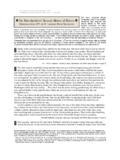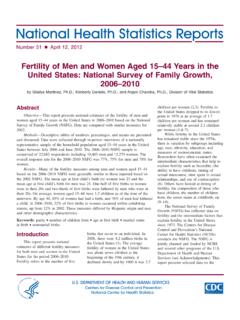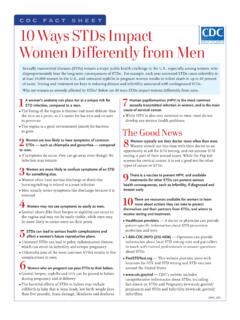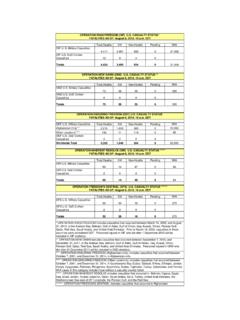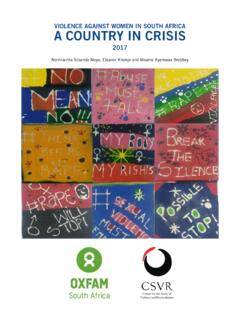Transcription of APA Guidelines for Psychological Practice with Boys and Men
1 APA | Guidelines for Psychological Practice with Boys and Men IAPA Guidelines for Psychological Practice with Boys and MenAUGUST 2018II A PA | Guidelines for Psychological Practice with Boys and MenCopyright 2018 by the American Psychological Association. This material may be reproduced and distributed without permission provided that acknowledgment is given to the American Psychological Association. This material may not be reprinted, translated, or distributed electronically without prior permission in writing from the publisher. For permission, contact APA, Rights and Permissions, 750 First Street, NE, Washington, DC 20002-4242. This document was approved by the APA Council of Representatives over the course of its meeting August 2018, and is set to expire in approximately 2028. It is available online at CitationAmerican Psychological Association, Boys and Men Guidelines Group.
2 (2018). APA Guidelines for Psychological Practice with boys and men. Retrieved from for Psychological Practice for Boys and Men was developed by several groups of individuals beginning in 2005 and continuing with updates and revisions through 2018. The final draft was compiled and updated by Fredric Rabinowitz, Matt Englar-Carlson, Ryon McDermott, Christopher Liang, and Matthew Kridel, with assistance from Christopher Kilmartin, Ronald Levant, Mark Kiselica, Nathan Booth, Nicholas Borgogna, and April Berry. Guidelines recommendations and selected literature were determined with the assistance and expertise of several scholars: Michael Addis, Larry Beer, Matt Englar-Carlson, Sam Cochran, lore m. dickey, William B. Elder, Anderson J. Franklin, Glenn Good, Michele Harway, Denise Hines, Andy Horne, Anthony Isacco, Chris Kilmartin, Mark Kiselica, Ron Levant, Christopher Liang, William Liu, David Lisak, James Mahalik, Ryon McDermott, Michael Mobley, Roberta Nutt, James O Neil, Wizdom Powell, Fredric Rabinowitz, Aaron Rochlen, Jonathan Schwartz, Andrew Smiler, Warren Spielberg, Mark Stevens, Stephen Wester, and Joel Wong.
3 The authors gratefully acknowledge the APA staff support for several years under the leadership of Ron Palomares. APA GUIDELINESfor Psychological Practice with Boys and MenAUGUST 2018 APA | Guidelines for Psychological Practice with Boys and Men 1 INTRODUCTIONBoys and men are diverse with respect to their race, ethnicity, culture, migration status, age, socioeconomic status, ability status, sexual orientation, gender identity, and religious affiliation. Each of these social identities contributes uniquely and in intersecting ways to shape how men experience and perform their masculinities, which in turn contribute to relational, Psychological , and behavioral health outcomes in both positive and negative ways ( , Arellano-Morales, Liang, Ruiz, & Rios-Oropeza, 2015; Kiselica, Benton-Wright, & Englar-Carlson, 2016). Although boys and men, as a group, tend to hold privilege and power based on gender, they also demonstrate disproportionate rates of receiving harsh discipline ( , suspension and expulsion), academic challenges ( , dropping out of high school, particularly among African American and Latino boys), mental health issues ( , completed suicide), physical health problems ( , cardiovascular problems), public health concerns ( , violence, substance abuse, incarceration, and early mortality), and a wide variety of other quality-of-life issues ( , relational problems, family well-being; for comprehensive reviews, see Levant & Richmond, 2007; Moore & Stuart, 2005; O Neil, 2015).
4 Additionally, many men do not seek help when they need it, and many report distinc-tive barriers to receiving gender-sensitive Psychological treatment (Mahalik, Good, Tager, Levant, & Mackowiak, 2012). The development of Guidelines for Psychological Practice with boys and men may help to attend to the barriers that lead to the aforementioned disparities. Indeed, the American Psychological Association (APA) has developed Guidelines for psychologists working with specific populations such as gay/lesbian/bisexual clients (2012), racial and ethnic minori-ty clients (2017a), older adults (2014), transgender and gender-non-conforming persons (2015a), and girls and women (2007). The APA also has developed Guidelines for psycho-logical Practice in health care delivery systems (2013a), forensic psychology (2013b), and Psychological evaluation in child protection matters (2013c). These Guidelines serve to (a) improve service delivery among populations, (b) stimulate public policy initiatives, and (c) provide professional guidance based on advances in the field.
5 Accordingly, the present doc-ument offers Guidelines for Psychological Practice with boys and A PA | Guidelines for Psychological Practice with Boys and MenPurpose and ScopeProfessional Practice Guidelines are statements that suggest or recommend specific professional behavior, endeavor, or conduct for psychologists (APA, 2015b). Guidelines differ from standards in that standards are mandatory and may be accompanied by an enforcement mechanism. Thus, Guidelines are aspirational in intent, and they are intended to facilitate the continued systematic development of the profession to help assure a high level of profes-sional Practice by psychologists (APA, 2015b). Guidelines may be superseded by federal or state laws, and APA (2015b) distinguish-es between clinical Practice Guidelines and Professional Practice Guidelines , noting that the former provides specific recommenda-tions about clinical interventions whereas the latter are designed to guide psychologists in Practice with regards to particular roles, populations, or settings and provide them with the current scholar-ly literature.
6 Representing [and] reflect consensus within the field (p. 823). Additionally, as noted by APA (2015b), Guidelines may not be applicable to every professional and clinical situation (p. 824). Thus, these Guidelines are not definitive and are designed to respect the decision-making judgment of individual professional psychologists. In addition, consistent with the recommendations and procedures outlined by APA (2015b), these Guidelines will need to be periodically reviewed and updated at least every 8 to 10 years, from the year of acceptance by the APA Council of Representatives, to take into account advances in research, changes in Practice , and the effects of changing contemporary social forces and context. Hence, readers are advised to check the current status of these Guidelines to ensure that they are still in effect and have not been superseded by subsequent present document articulates Guidelines that enhance gender- and culture-sensitive Psychological Practice with boys and men from diverse backgrounds in the United States.
7 These guide-lines provide general recommendations for psychologists who seek to increase their awareness, knowledge, and skills in Psychological Practice with boys and men. The beneficiaries of these Guidelines include all consumers of Psychological Practice including clients, students, supervisees, research participants, consultees, and other health professionals. Although the Guidelines and supporting lit-erature place substantial emphasis on psychotherapy Practice , the general Guidelines are applicable to all Psychological Practice ( , individual, couples and family work, group work, psycho-ed-ucational programming, consultation, prevention, teaching, career counseling) across multiple helping professions ( , nursing, social work, counseling, school counseling, psychiatry). Rather than offering a comprehensive review of content relevant to all areas of Practice , this document provides examples of empirical and con-ceptual literature that support the need for Practice Guidelines with boys and men.
8 We encourage institutions, agencies, departments, and/or individuals to discuss ways in which these Guidelines may be applied to their own settings and relevant refers to Psychological , social, and cultural experiences and characteristics associated with the social statuses of girls and women or boys and men, whereas sex refers to biological aspects of being male or female. Gender includes assumptions, social beliefs, norms, and stereotypes about the behavior, cognitions, and emotions of males and females (Pleck, 1981, 1995). Gender norms and stereotypes also vary within and between groups associated with other dimensions of diversity such as ethnicity, sexual orien-tation (McDermott et al., 2017), ability (Griffith & Thorpe, 2016), socioeconomic class (Liu, 2017; Liu, Colbow, & Rice, 2016), and race (Hammond, Fleming, & Villa-Torres, 2016; McDermott et al.)
9 , 2017). Although gender and sex can be seen as overlapping and fluid categories with multiple meanings (Marecek, 2002), this doc-ument uses the term gender to refer primarily to the social expe-riences, expectations, and consequences associated with being a boy or is used to refer to people whose sex assigned at birth is aligned with their gender identity (Green, 2006; Serano, 2006). These Guidelines address conflict that cisgender, transgender, and gender-nonconforming individuals may experience due to societal expectations regarding gender roles (Butler, 1990). GENDER BIAS The term gender bias refers to beliefs and attitudes that involve stereotypes or preconceived ideas about the roles, abilities, and characteristics of males and females that may contain significant distortions and inaccuracies. Psychologists have an ethical obliga-tion to recognize and confront these biases (APA, 2010).
10 GENDER ROLE STRAIN Gender role strain is a Psychological situation in which gender role demands have negative consequences on the individual or others (for reviews, see Pleck, 1981, 1995). The negative effects of gender role strain are mental and physical health problems for the individ-ual and within relationships (O Neil, 2008, 2013; Pleck, 1995). Boys and men experience gender role strain when they (a) deviate from or violate gender role norms of masculinity, (b) try to meet or fail to meet norms of masculinity, (c) experience discrepancies between real and ideal self-concepts based on gender role stereotypes, (d) personally devalue, restrict, or violate themselves, (e) experience personal devaluations, restrictions, or violations from others, and/or (f) personally devalue, restrict, or violate others because of gen-der role stereotypes (Pleck, 1995).MASCULINITY IDEOLOGYM asculinity ideology is a set of descriptive, prescriptive, and pro-scriptive of cognitions about boys and men (Levant & Richmond, 2007; Pleck, Sonenstein, & Ku, 1994).










